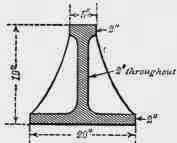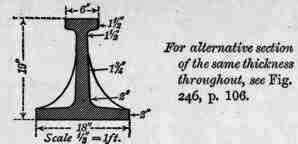Girder With Feathers
Description
This section is from the book "Notes On Building Construction", by Henry Fidler. Also available from Amazon: Notes on building construction.
Girder With Feathers
Sometimes ribs or "feathers" are cast upon the web of the girder, as at // in Fig. 247, as stiffeners to strengthen it. They are, however, troublesome to cast, and tend to cause an objectionable stress upon the casting (see Part III.) at the angles where they join the girder. This is to some extent avoided by stopping the feathers short of the top flange, as in Figs. 247, 249. In Fig. 246 they are carried up to the top.

Fig. 246.
1 The curve of the upper flange of a cast-iron girder of uniform width, uniformly loaded throughout its length, is theoretically nearly a parabola (something between an ellipse and a parabola), but practically a circular arc is used and the depth of the ends of the girder is made half that at its centre.
2 The curves of the sides of the flanges in plan are parabolas.
Fig. 247. Elevation.


Fig. 248. Plan.

Fig. 249. Cross Section at Centre. Cast-iron Girder of Uniform Strength and Uniform Width.
Fig. 250. Elevation.


Fig. 251. Plan. Cast-iron Girder of Uniform Strength and Uniform Depth.
Continue to:


